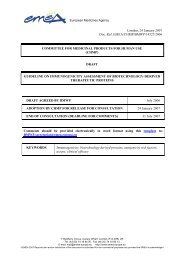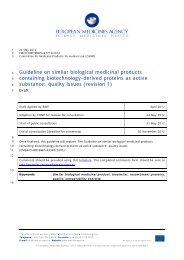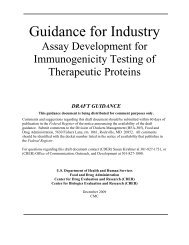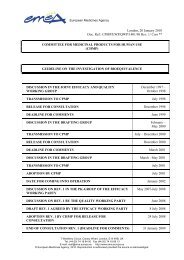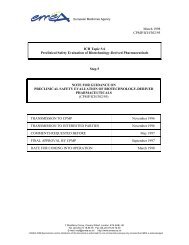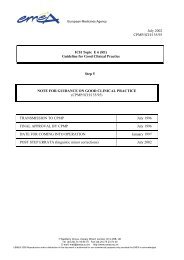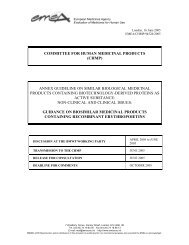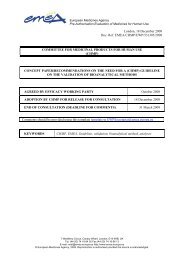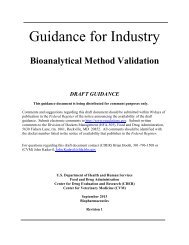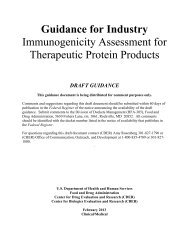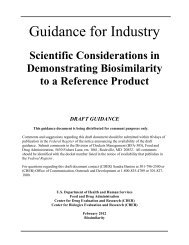Guidance for Industry - Assay Development
Assay Development for Immunogenicity Testing of Therapeutic Proteins, Draft Guidance http://www.ipm-biotech.de/fileadmin/user_upload/pdf/guidelines/FDA-GUIDANCE-Assay-Development-Immunogenicity-Testing.pdf
Assay Development for Immunogenicity Testing of Therapeutic Proteins, Draft Guidance
http://www.ipm-biotech.de/fileadmin/user_upload/pdf/guidelines/FDA-GUIDANCE-Assay-Development-Immunogenicity-Testing.pdf
You also want an ePaper? Increase the reach of your titles
YUMPU automatically turns print PDFs into web optimized ePapers that Google loves.
129<br />
130<br />
131<br />
132<br />
133<br />
134<br />
135<br />
136<br />
137<br />
138<br />
139<br />
140<br />
141<br />
142<br />
143<br />
144<br />
145<br />
146<br />
147<br />
148<br />
149<br />
150<br />
151<br />
152<br />
153<br />
154<br />
155<br />
156<br />
157<br />
158<br />
159<br />
160<br />
161<br />
162<br />
163<br />
164<br />
165<br />
166<br />
167<br />
168<br />
169<br />
170<br />
171<br />
172<br />
173<br />
174<br />
Contains Nonbinding Recommendations<br />
Draft — Not <strong>for</strong> Implementation<br />
antibody responses be reported as a titer (e.g., the reciprocal of the highest dilution that gives a<br />
value equivalent to the cut point of the assay). Values may also be reported as amount of drug<br />
(in mass units) neutralized per volume serum with the caveat that these are arbitrary in vitro<br />
assay units and cannot be used to directly assess drug availability in vivo. Antibody levels<br />
reported in mass units based on interpolation of data from standard curves generated with a<br />
positive control standard antibody are generally less in<strong>for</strong>mative because interpretation is based<br />
on the specific control antibody.<br />
2. Aspects of <strong>Assay</strong> <strong>Development</strong><br />
There are several important concepts to remember when using this multi-tiered approach to<br />
assess immunogenicity. First, the initial screening should be very sensitive. A low, but defined<br />
false positive rate is desirable because it maximizes detection of true positives. Other assays can<br />
be subsequently employed to exclude false positive results when determining the true incidence<br />
of immunogenicity.<br />
Second, the assay should be able to detect all isotypes (particularly immunoglobulin M (IgM)<br />
and the different immunoglobulin G (IgG) isotypes).<br />
Third, FDA recognizes that antibodies generated in patients may have varied avidities <strong>for</strong> the<br />
product, while the positive controls used to validate the assay and demonstrate data legitimacy<br />
may only represent a subset of potential avidities. Although this may be unavoidable, FDA<br />
recommends the applicant carefully consider the avidity of controls used to evaluate the assay.<br />
A fourth consideration is how interference from biological materials (matrix, e.g., serum,<br />
plasma) will affect assay per<strong>for</strong>mance. The applicant should conduct assay per<strong>for</strong>mance tests in<br />
the same concentration of matrix as that used to assess patient samples. The applicant should<br />
also define the dilution factor that will be used <strong>for</strong> preparation of patient samples be<strong>for</strong>e<br />
validation studies assessing potential interference of matrix on assay results.<br />
B. Screening <strong>Assay</strong><br />
1. Selection of Format<br />
A number of different <strong>for</strong>mats are available <strong>for</strong> screening assays. These include, but are not<br />
limited to, direct binding enzyme-linked immuno sorbent assay (ELISA), bridging ELISA,<br />
radioimmunoprecipitation assays (RIPA), surface plasmon resonance (SPR), Bethesda <strong>Assay</strong><br />
(<strong>for</strong> clotting factor inhibitors, see section VIII, 3), and bridging electrochemiluminescence<br />
assays. Each assay has its advantages and disadvantages as far as rapidity of throughput,<br />
sensitivity, and availability of reagents. One of the major differences between each of these<br />
assays is the number and vigor of washes, which can have an effect on assay sensitivity. Epitope<br />
exposure is also important to consider as binding to plastic or coupling to other agents (e.g.,<br />
fluorochromes) can obscure relevant antibody binding sites on the protein product in question.<br />
2. Selection of <strong>Assay</strong> and Reagents<br />
C:\8495dft.doc<br />
11/4/09<br />
4




